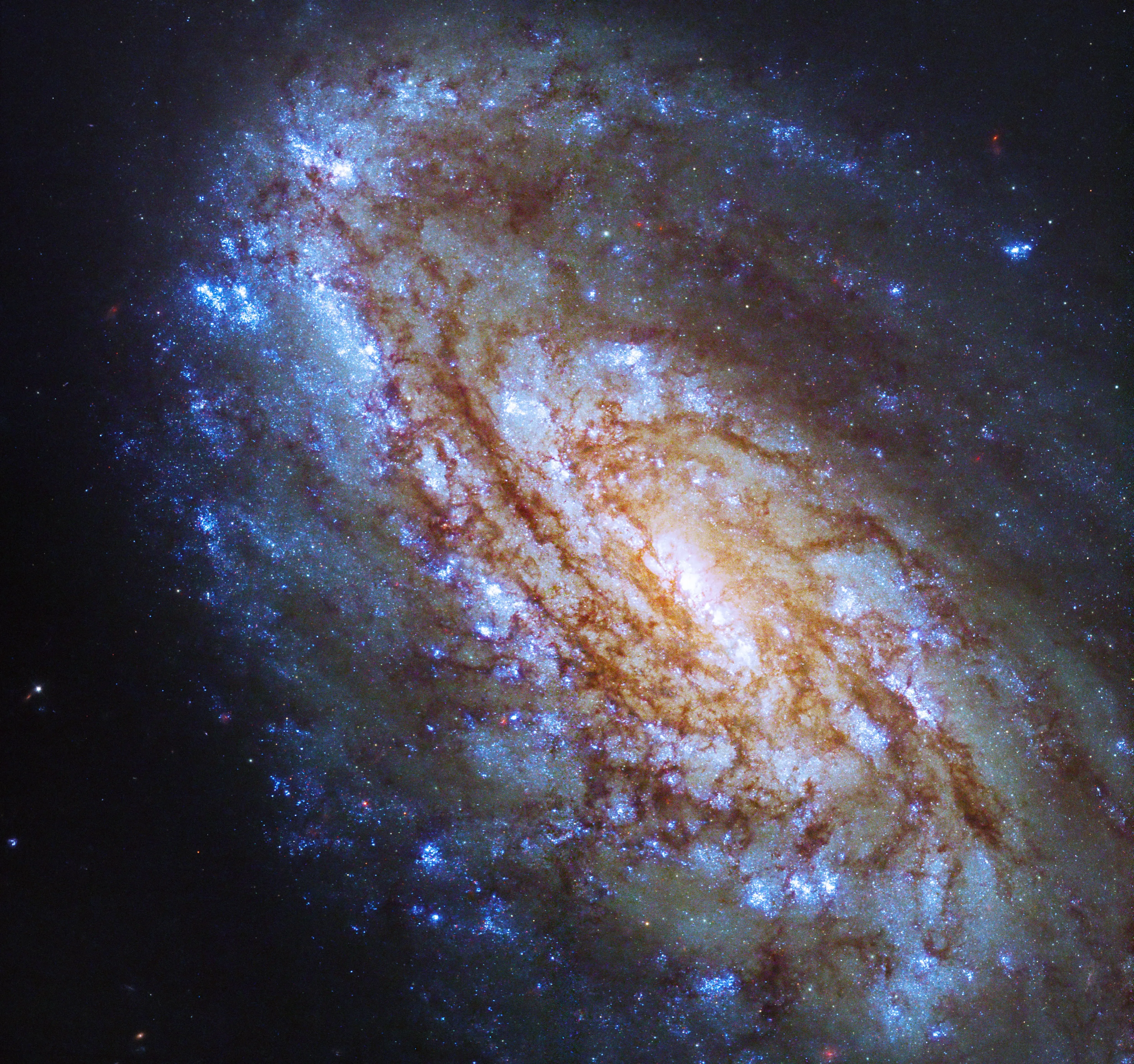NASA, ESA, Space Telescope Science Institute/J. Lee; Processing: NASA/Catholic University of America/Gladys Kober
It’s easy to get swept up in the swirling starry arms of this intermediate spiral galaxy, NGC 4654, in the constellation Virgo. The galaxy has a bright center and is labeled “intermediate” because it has characteristics of both unbarred and barred spirals. NGC 4654 is just north of the celestial equator, making it visible from the northern hemisphere and most of the southern hemisphere. The galaxy is around 55 million light-years from Earth.
NGC 4654 is one of many Virgo Cluster galaxies that have an asymmetric distribution of stars and of neutral hydrogen gas. Astronomers reason that NGC 4654 may be experiencing a process called “ram pressure stripping,” where the gravitational pull of the Virgo galaxy cluster puts pressure on NGC 4654 as it moves through a superheated plasma made largely of hydrogen called the “intracluster medium.” This pressure feels like a gust of wind – think of a biker feeling wind even on a still day – that strips NGC 4654 of its gas. This process produced a long, thin tail of hydrogen gas on the galaxy’s southeastern side. Most galaxies that experienced ram pressure stripping hold very little cold gas, halting the galaxy’s ability to form new stars, since stars generate from dense gas. However, NGC 4654 has star formation rates consistent with other galaxies of its size.
NGC 4654 also had an interaction with the companion galaxy NGC 4639 about 500 million years ago. The gravity of NGC 4639 stripped NGC 4654’s gas along its edge, limiting star formation in that region and causing the asymmetrical distribution of the galaxy’s stars.
Scientists study galaxies like NGC 4654 to examine the connection between young stars and the cold gas from which they form. NASA’s Hubble Space Telescope took this image in visible, ultraviolet, and infrared light.
Hubble shared a brand-new galaxy image every day Oct. 2-7, 2023. See the new images and learn more about galaxies.
影像来源: NASA, ESA, Space Telescope Science Institute/J. Lee; 影像处理: NASA/Catholic University of America/Gladys Kober
人们很容易被室女座内中间螺旋星系NGC 4654的旋转状星臂所吸引。这个星系有一个明亮的中心,被称为“中间星系”,因为它同时具有无棒和有棒螺旋的特征。NGC 4654位于天赤道以北,因此在北半球和南半球的大部分地区都能看到它。该星系距离地球约5,500万光年。
NGC 4654是众多室女座星系团中的一个,它拥有不对称的恒星和中性氢气分布。天文学家推断,NGC 4654可能正在经历一个被称为“冲压压力剥离”的过程,即室女座星系团的引力在NGC 4654穿过一种主要由氢构成的过热等离子体(称为“星系团内介质”)时对其施加压力。这种压力就像一阵风——想象一下一个骑自行车的人即使在无风的日子里也能感受到风——把NGC 4654的气体吹走了。这个过程在星系的东南侧产生了一条细长的氢气尾巴。大多数经历了冲压压力剥离的星系只拥有非常少的冷气体,这阻碍了星系形成新恒星的能力,因为恒星是由致密气体中产生。然而,NGC 4654的恒星形成率与它大小的其他星系一致。
大约5亿年前,NGC 4654也与伴星系NGC 4639发生了相互作用。NGC 4639的引力沿着其边缘剥离了NGC 4654的气体,限制了该区域的恒星形成,并导致星系恒星的不对称分布。
科学家们研究像NGC 4654这样的星系是为了研究年轻恒星和形成它们的冷气体之间的联系。NASA的哈勃太空望远镜在可见光、紫外线和红外光下拍摄了这张照片。
2023年10月2日至7日,哈勃每天都会分享一张全新的星系图像。查看新的图像,了解关于星系的更多信息。




真神奇!